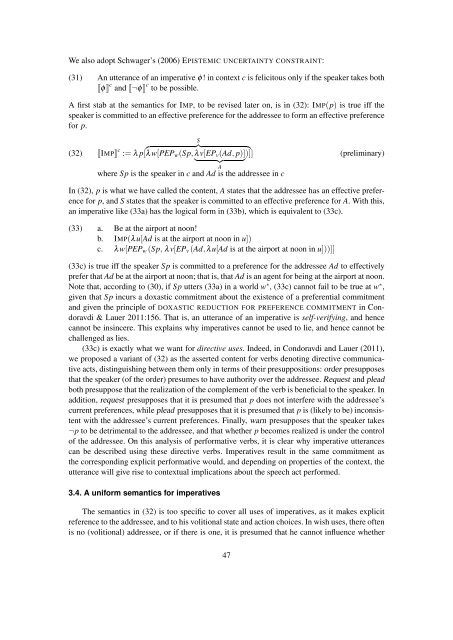Empirical Issues in Syntax and Semantics 9 (EISS 9 ... - CSSP - CNRS
Empirical Issues in Syntax and Semantics 9 (EISS 9 ... - CSSP - CNRS
Empirical Issues in Syntax and Semantics 9 (EISS 9 ... - CSSP - CNRS
Create successful ePaper yourself
Turn your PDF publications into a flip-book with our unique Google optimized e-Paper software.
We also adopt Schwager’s (2006) EPISTEMIC UNCERTAINTY CONSTRAINT:<br />
(31) An utterance of an imperative φ! <strong>in</strong> context c is felicitous only if the speaker takes both<br />
φ c <strong>and</strong> ¬φ c to be possible.<br />
A first stab at the semantics for IMP, to be revised later on, is <strong>in</strong> (32): IMP(p) is true iff the<br />
speaker is committed to an effective preference for the addressee to form an effective preference<br />
for p.<br />
S<br />
{ }} {<br />
(32) IMP c := λ p[ λw[PEP w (Sp,λv[EP v (Ad, p)] )]] (prelim<strong>in</strong>ary)<br />
} {{ }<br />
where Sp is the speaker <strong>in</strong> c <strong>and</strong> Ad is the addressee <strong>in</strong> c<br />
A<br />
In (32), p is what we have called the content, A states that the addressee has an effective preference<br />
for p, <strong>and</strong> S states that the speaker is committed to an effective preference for A. With this,<br />
an imperative like (33a) has the logical form <strong>in</strong> (33b), which is equivalent to (33c).<br />
(33) a. Be at the airport at noon!<br />
b. IMP(λu[Ad is at the airport at noon <strong>in</strong> u])<br />
c. λw[PEP w (Sp, λv[EP v (Ad,λu[Ad is at the airport at noon <strong>in</strong> u]))]]<br />
(33c) is true iff the speaker Sp is committed to a preference for the addressee Ad to effectively<br />
prefer that Ad be at the airport at noon; that is, that Ad is an agent for be<strong>in</strong>g at the airport at noon.<br />
Note that, accord<strong>in</strong>g to (30), if Sp utters (33a) <strong>in</strong> a world w ∗ , (33c) cannot fail to be true at w ∗ ,<br />
given that Sp <strong>in</strong>curs a doxastic commitment about the existence of a preferential commitment<br />
<strong>and</strong> given the pr<strong>in</strong>ciple of DOXASTIC REDUCTION FOR PREFERENCE COMMITMENT <strong>in</strong> Condoravdi<br />
& Lauer 2011:156. That is, an utterance of an imperative is self-verify<strong>in</strong>g, <strong>and</strong> hence<br />
cannot be <strong>in</strong>s<strong>in</strong>cere. This expla<strong>in</strong>s why imperatives cannot be used to lie, <strong>and</strong> hence cannot be<br />
challenged as lies.<br />
(33c) is exactly what we want for directive uses. Indeed, <strong>in</strong> Condoravdi <strong>and</strong> Lauer (2011),<br />
we proposed a variant of (32) as the asserted content for verbs denot<strong>in</strong>g directive communicative<br />
acts, dist<strong>in</strong>guish<strong>in</strong>g between them only <strong>in</strong> terms of their presuppositions: order presupposes<br />
that the speaker (of the order) presumes to have authority over the addressee. Request <strong>and</strong> plead<br />
both presuppose that the realization of the complement of the verb is beneficial to the speaker. In<br />
addition, request presupposes that it is presumed that p does not <strong>in</strong>terfere with the addressee’s<br />
current preferences, while plead presupposes that it is presumed that p is (likely to be) <strong>in</strong>consistent<br />
with the addressee’s current preferences. F<strong>in</strong>ally, warn presupposes that the speaker takes<br />
¬p to be detrimental to the addressee, <strong>and</strong> that whether p becomes realized is under the control<br />
of the addressee. On this analysis of performative verbs, it is clear why imperative utterances<br />
can be described us<strong>in</strong>g these directive verbs. Imperatives result <strong>in</strong> the same commitment as<br />
the correspond<strong>in</strong>g explicit performative would, <strong>and</strong> depend<strong>in</strong>g on properties of the context, the<br />
utterance will give rise to contextual implications about the speech act performed.<br />
3.4. A uniform semantics for imperatives<br />
The semantics <strong>in</strong> (32) is too specific to cover all uses of imperatives, as it makes explicit<br />
reference to the addressee, <strong>and</strong> to his volitional state <strong>and</strong> action choices. In wish uses, there often<br />
is no (volitional) addressee, or if there is one, it is presumed that he cannot <strong>in</strong>fluence whether<br />
47











